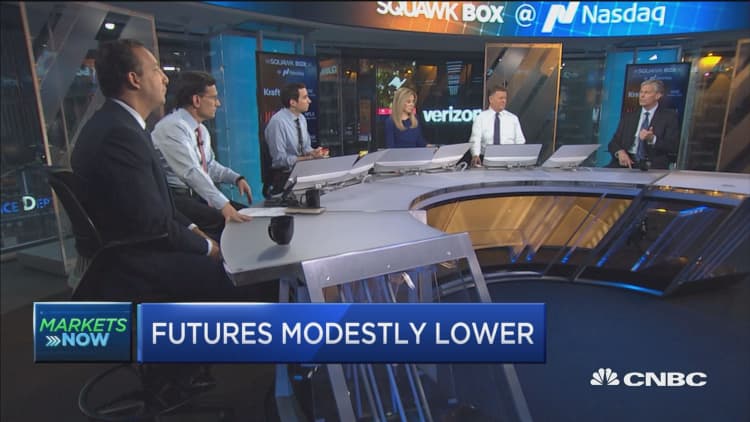
Bank shares fell broadly on Wednesday amid growing concerns that the recent Republican electoral losses could hinder the party's push to reform the U.S. tax code. They have also been pressured by a flattening yield curve.
The SPDR S&P bank exchange-traded fund (KBE) fell 0.7 percent and notched its fourth straight negative session. Bank of America was among the worst performers in the ETF, sliding 1.5 percent.
The banks fell after Republicans lost key elections in New Jersey and Virginia on Tuesday. These losses increase uncertainty around the GOP's plans to move forward with tax reform.
"Election results last night in Virginia could push Republicans to take a more populist approach on tax legislation, which could limit the scope of corporate tax changes," said Brian Gardner, managing director at Keefe, Bruyette & Woods, in a note.
"The election results could also signal that the House might flip after the 2018 elections, which could lead to Rep. Maxine Waters (D-CA) chairing the House Financial Services Committee. We see that as a negative for financial stocks, especially large-cap banks," Gardner said.
Banks were also pressured by a flattening yield curve. The spread between the two and the 10-year U.S. bond yields hovered around 70 basis points, its lowest level in a decade. A flattening yield curve is sometimes the precursor of an inverted curve, which has been a recession warning.
For now, "I'm not worried because, if you look at balance sheets and corporate earnings, they are still pretty good," said Ninh Chung, head of investment strategy and portfolio management at Silicon Valley Bank. "But if we get an inverted yield curve, that would be more concerning."
Over the past year, banks have easily outperformed the broader market. The KBE is up 26 percent since November 2016, while the S&P 500 has gained 21 percent in that time period.
Jason Goldberg, managing director at Barclays, told CNBC's "Power Lunch" on Wednesday the space's main driver has been tighter monetary policy. "The Fed has hiked several times since the election … and is slated to continue to do so."
The Federal Reserve is widely expected to raise interest rates in December. Market expectations for a December rate hike are nearly 97 percent, according to the CME Group's FedWatch tool.
The major stock indexes, meanwhile, finished slightly higher and eked out record closing highs.
The Dow Jones industrial average rose 6.13 points to close at 23,563.36, with Wal-Mart and Merck as the best-performing stocks in the index. Wal-Mart and Merck rose 1.5 percent and 1.8 percent, respectively.
The S&P 500 closed 0.1 percent higher at 2,594.38, with consumer staples as the best-performing sector. The Nasdaq composite rose 0.3 percent to 6,789.12.
Major U.S. Indexes
Wall Street also looked back to President Donald Trump's election, which happened exactly one year ago. Since his election, the major indexes are up more than 20 percent. Trump's election victory brought with it hopes of tax reform, which lifted investor sentiment.
Some of the best-performing spaces since Nov. 8, 2016 include aerospace and defense and technology, which are both up about 40 percent in that time span.
The postelection rally has also been marked by very low volatility. Last week, the CBOE Volatility index (Vix) broke below 9 for the third time ever.
"Although no one at the time would have believed it, the 12 months since Election Day have been among the least volatile ever for equity markets," said Ryan Detrick, senior market strategist at LPL Financial, in a post. "Not to mention the solid 21% gain the S&P 500 Index racked up along the way that has the bulls smiling."
The S&P 500 has also had one of its longest runs in decades without a 3 or 5 percent decline.
However, the market's strong run since the election also coincides with improving global economic conditions, according to Michael Shaoul, chairman and CEO of Marketfield Asset Management. "That's one big reason why stocks have rallied so much," he said. "I don't deny that the election had an impact on sentiment," but this is really a story about strength in the global economy.
For the week, the three major indexes are on track to post modest gains as earnings season winds down.
"Most of the earnings are already out," said Maris Ogg, president at Tower Bridge Advisors. "I wouldn't be surprised if the market holds here for a bit since the news flow is pretty meager."
Some of the companies that have reported this week include Snap and Lending Club, which fell sharply as its results disappointed investors.
This earnings season has been a strong one. With 87 percent of S&YP 500 companies having reported, earnings have grown 6.4 percent year over year, as 74 percent of companies have surpassed Wall Street expectations, according to FactSet.


